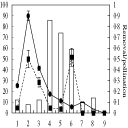Phenology and Phenotypic Natural Selection on the Flowering Time of a Deceit-pollinated Tropical Orchid, Myrmecophila christinae

Fooling some of the bees some of the time
In flowers that are pollinated by animals, whether invertebrate or vertebrate, it is usually the case that the pollinator is offered a reward, for example, nectar. However, as reviewed by two Mexican botanists (Parra-Tabla and Vargas, pp. 243�250) some plants attract pollinators without offering a reward. This is known as deceit pollination and is particularly common in the family Orchidaceae: up to one-third of orchid species, perhaps numbering around 10000, deceive their pollinators. In plants offering a reward, synchrony of flowering encourages multiple visits and hence maximizes pollen transfer. However, in plants utilizing deceit, naïve pollinators that are initially deceived may quickly learn that no reward is offered and give up visiting the flowers. It may therefore be advantageous to maintain a low frequency of plants in flower, an example of negative frequency-dependent selection. This further implies that individuals which flower early or late in the flowering season are more likely to be pollinated than individuals that flower at the height of the season. The authors have been able to test this by studying reproductive efficiency in Myrmecophila christinae, a deceit-pollinated epiphytic orchid of the Yucat�n peninsula. Their data show that, indeed, both donation of pollen to pollinators and receipt of pollen are more frequent in plants that flower earlier or later than the main flowering period. However, the authors also report that the effect is variable from year to year, suggesting that there are other factors that contribute to breeding success. One such factor is the abundance of the bee species that act as pollinators. Further, we note that, despite the greater reproductive success attained by flowering at the beginning and end of the season, M. christinae nevertheless exhibits very marked peaks of higher flower abundance. The selective advantage of this is not at all obvious but it clearly illustrates the complexity of floral evolution.
j.a.bryant{at}exeter.ac.uk